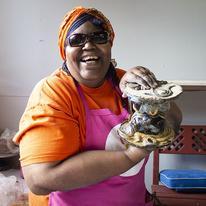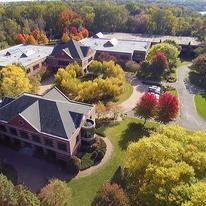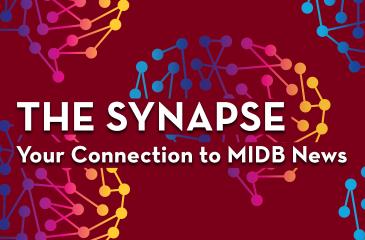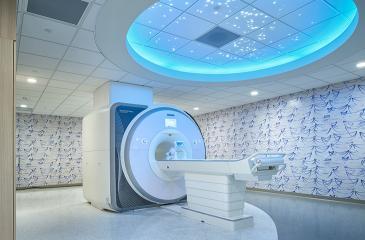The Synapse: May 2021
MIDB Facility Construction Update
At 70 percent completion, construction on MIDB’s 116,000 square foot facility is on track to be ready for units and departments to begin moving into the building this October. The building will be open to patients and the public Nov. 1.
Located at 2025 E. River Parkway in Minneapolis, the 10.2-acre property includes a two-level building with research and clinical spaces, as well as community space and an attached parking lot.
Using warm textures and natural colors, the visual theme of the new MIDB facility draws on its connection to the Mississippi River, located just south of the building.
Several murals throughout the building are designed to complement that theme and invoke a spirit of playfulness, wayfinding and welcoming through the entire public and patient/visitor areas of the building.
Created by MIDB's design architect HGA in collaboration with the MIDB University Project Team, the first floor murals reflect the flow of the river, and the second floor murals reflect the treetops that run along the river. The designs were chosen to relate to young children while respecting that MIDB will service the needs of many ages, including teens, young adults and adults.
Located approximately one mile from campus, the site is easily accessible for patients, families and visitors. Outdoor spaces include beautiful grounds with indigenous plants, a playground, and access to nearby walking paths.
The new home of MIDB will offer a serene and welcoming environment when it opens this fall.


Non-Suicidal Self-Injury in the Context of COVID-19: The Importance of Psychosocial Factors for Female Adolescents
University researchers recently published their findings on adolescent mental health in the COVID-19 pandemic. They reported on results from a longitudinal study examining predictors of engaging in non-suicidal self-injury (NSSI) in adolescents. Their findings provide preliminary evidence that perceptions of stress and external coping resources, including support from family members, are relevant in the face of the unprecedented stressors brought on by the COVID-19 pandemic. "The pandemic is inducing similar stressors on a global scale, allowing for us to assess NSSI under unique stress conditions," said Kathryn Cullen, MD, associate professor of psychiatry and behavioral sciences. "Our findings during such conditions may elucidate possible avenues of treatment and new research. With these advances, we can hope to mitigate the use of NSSI and arm adolescents with more adaptive strategies for coping with distress and to lessen the risk for continued suffering and suicide risk, and improve mental health prognosis." This project was supported by the UMN Campus Public Health Officer's CO:VID (Collaborative Outcomes: Visionary Innovation & Discovery) grants program.

Identifying Autism Earlier Than Ever
Most autistic children do not receive their formal diagnosis until around age five. Jed T. Elison, PhD, a faculty member in the U’s Institute of Child Development, and his colleagues are finding new ways to detect and address neurodevelopmental disabilities like autism much earlier, which can pay big dividends. The team is currently collecting new data to replicate game-changing evidence indicating that patterns of brain development at six and 12 months of age can be used to predict which individuals will later receive an autism diagnosis at 24 months. The researchers believe that identifying children at increased likelihood for developing autism as early as possible will allow them to leverage the plasticity inherent to the first 1,000 days and build skills in these children to enhance their developmental potential. Learn more about Elison’s research.

A Touch of Color
“Ceramics is a chemical and visual field, where I have to know about color, but I only see black, white, and gray, so I have to be very social in my community,” said artist Donna Ray. As a child, she soaked in compliments from family and friends about a red velvet Christmas dress or a pink Easter bonnet, relating their descriptions and the feel of the finery to her imagination of color. Recently, Ray shared her artistic vision with community members and high school artists as part of Art for All, the Stephanie Evelo Program for Art Inclusion at the Institute on Community Integration. The program features Ray in a solo exhibition, “Black and White with a Touch of Color,” running through May 31. Read more about Ray.

Building A Healthier Future Together
Last year, Minnesota Masonic Charities became the first donor to help create and launch MIDB. Building on its remarkable legacy of support for the University of Minnesota to tackle some of the most leading-edge research in cancer and children's health, Minnesota Masonic Charities committed $35 million to establish and name the Masonic Institute for the Developing Brain. “Our long-standing partnership with the University of Minnesota aligns with our mission to make meaningful contributions to society. MIDB is another example of how we can unite the incredible expertise of the University with the capacity of Minnesota Masonry to benefit our entire state and, indeed, the world,” said Eric Neetenbeek, president and CEO of Minnesota Masonic Charities.

Autism Lives
Jules Edwards was 32 when she was diagnosed with autism, along with her children. Tom Cox was in his 40s when one of his employees suggested he might look into Asperger syndrome. Those turning points, they say, led both of them to a deeper understanding of themselves and the world around them. Today, Edwards and Cox are leaders in Minnesota’s autism advocacy community. “We see a lot of negative messaging and portrayals of autistic traits. It’s important to know autistic people are complete human beings,” said Edwards, a current fellow in the Minnesota Leadership Education in Neurodevelopmental and Related Disabilities program at the Institute on Community Integration. “Autism isn’t good, and it isn’t bad. It just is.” Read more about their advocacy volunteer work.

Brain2Brain: Livestreams with Researchers
All videos from the Bell Museum's live conversations with University of Minnesota researchers showcasing their exciting work in brain science are now available online. Topics include a brain scan in real time; exploring what the brain does, how it grows, and how it can trick you; the consequences of brain injury and drug addiction; getting in touch with your emotions, from a scientific perspective; and more. Watch the videos now.



